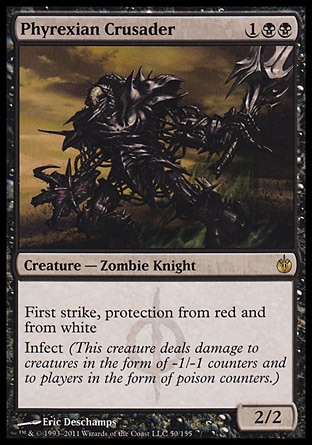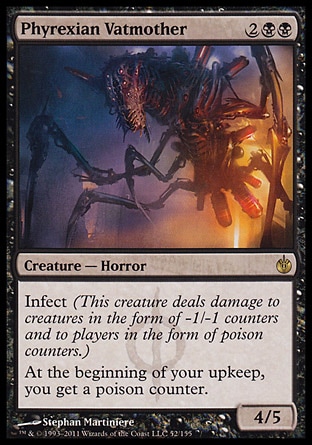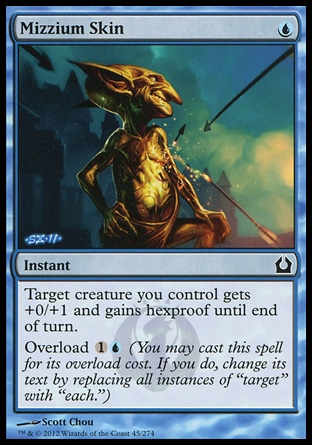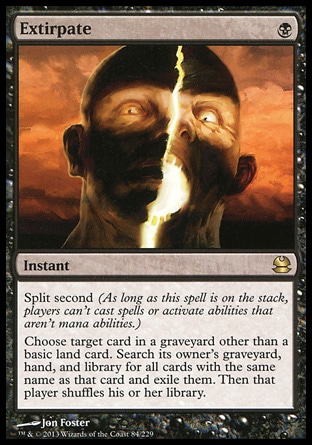Hello and welcome to what I hope will spark a regular column about budget Modern decks on MTGSalvation! My passion in Magic is budget decks, and has been for quite some time. As such, I am always willing to help out others when they want to buy in to the Modern format but cannot afford Tarmogoyf, Snapcaster Mage, or fetchlands. Additionally, the cost of Modern is rising, with Dredge priced at roughly $450, Ad Nauseum sitting at $600, and even Burn, the classic "most bang for your buck" archetype, costing over $600 for the optimal version. These examples are only the bottom of the buy in cost -- Jund Death's Shadow dwarfs other decks' prices at a whopping $1,500. If someone is seeking to break out into the big leagues at a StarCityGames Open or a Grand Prix, then these decks are necessary to compete. However, for the many others who are looking for a deck to play at their Friday Night Magic, there are budget-friendly options available from $300 to under $100.
For my first budget article, I want to present a deck that is not only unique but resilient. While this deck is rogue, it is not built to be janky. It is competitive enough for a local game store, and if you enjoy playing decks that are disruptive and play brutally efficient threats, this deck is for you! The best part is the price, which clocks in at $130! Behold, the glory of Phyrexia — Dimir Infect!
| Dimir InfectMagic OnlineOCTGN2ApprenticeBuy These Cards | ||
|---|---|---|
|
Threats (17) 4 Blighted Agent 4 Phyrexian Crusader 2 Phyrexian Vatmother 4 Plague Stinger 3 Runechanter's Pike Disruption (14) 4 Duress 3 Inquisition of Kozilek 3 Mizzium Skin 2 Fatal Push 2 Victim of Night | Card Draw (8) 4 Serum Visions 4 Sleight of Hand Lands (21) 4 Drowned Catacomb 5 Island 8 Swamp 4 Underground River | Sideboard (15): 1x Dismember 2x Dispel 3x Echoing Truth 2x Extirpate 1x Fatal Push 2x Hurkyl's Recall 2x Nihil Spellbomb 2x Pithing Needle |
Dimir Infect sits in a rather peculiar spot on the range if archetypes. It plays cheap spells to get ahead of the opponent, but not so quickly that it feels akin to Delver strategies. Additionally, it is not as fast as the more common green Infect strategies — the deck's threats hit the board after disruption paves the way. While this may translate to "midrange," it is not nearly as slow as Jund and Junk. I classify this deck as a tempo-midrange hybrid. While not as fast as Delver, its disruption can hold other decks at bay. However, particularly fast aggro decks can get underneath Dimir Infect, making the deck feel midrangey in certain matchups.
Dimir Infect can be broken up into three separate parts: threats, disruption, and card draw.

Threats
The infect creatures available in blue and black all have one key characteristic in common — they are all evasive. Plague Stinger is the simplest. A 1/1 flier with infect, while somewhat unimpressive on the surface, is a cheap threat. Combined with Modern's stark lack of fliers outside of blue/black Faeries and the occasional Lingering Souls, Plague Stinger can still get the opponent to 10 poison counters when combined with other threats.
Blighted Agent is familiar to anyone who plays Modern. While blue/green Infect seeks to pump this shifty creature for a swift kill, this deck uses Blighted Agent as a method for swinging past creatures. Plague Stinger and Blighted Agent together are the base for an early, more tempo-oriented game plan, if the player chooses to take that route. By starting the clock early, this deck can win through removal spells.
If Blighted Agent gives the opponent a headache, Phyrexian Crusader will give them a migraine so bad they will need a bye or two to recover, or at least cause them to flip a table. A 2/2 with first strike and protection from two colors with plenty of removal is already perfectly playable for three mana. Slap on infect and now it is the best card in the deck. Some decks such as Jeskai Nahiri, will struggle to find an answer for it. Other decks, like Red-White Nahiri Control and Burn, have no possible way of dealing with it. While it may be virtually unblockable in some matchups, even if it can be blocked — or when Crusader itself is blocking — it still poses a serious threat due to infect. Because infect deals damage to creatures in the form of -1/-1 counters, first strike is suddenly much more relevant. When first strike damage happens, the opponent's creature will get two -1/-1 counters, making it weaker when it deals its combat damage. Thus, your opponent needs a creature with at least four power to kill the Crusader, because a three power creature will become a one power creature before the normal damage step! The degree to which Phyrexian Crusader dominates the battlefield makes it a staple of the deck, and it is worth investing in your playset.

The last creature in our deck is Phyrexian Vatmother. While she is not evasive, she is a monstrous presence on the board. For Modern, a 4/5 is nasty in combat, and combined with infect, anything she will not kill on the first hit will be irrelevant for the rest of the game. Her "downside" is never going to matter — unless you are paired against another Infect deck, poison counters are nothing to be concerned with. She is a solid way to swing into a board stall, just like Blighted Agent. Unlike our unblockable friend, however, Phyrexian Vatmother would rather just stomp through the defense and flatten any opposition than avoid it entirely. She represents a must-deal-with threat before she gets out of hand, and if the opponent does not have an answer, they most likely will have 10 poison counters in a few turns.
While not technically a threat, Runechanter's Pike is worthy of mention here. As the game goes long, there is a need for another way to close out the game. Runechanter's Pike offers this in spades. It turns any of the deck's measly 1/1's into a game-ending threat at the drop of a hat. This card rewards the player for grinding out the opponent and is a surefire win condition. There are few things in Magic that feel quite as good as swinging with a 7/1 first strike Blighted Agent or Plague Stinger. Suffice to say, the Pike has earned its slots.
Disruption
With the threats out of the way, we can now move on to the disruption package. What the deck needs in disruption is cards which stop the opponent's own disruption. This disruption can come in the form of discard spells, removal spells, or opposing creatures. This deck's disruption suite is very flexible, and can easily be built to suit any metagame's needs.
For the discard suite, I chose to use four Duress and three Inquisition of Kozilek. Duress is useful for picking away the common removal spells of the format, but it also hits planeswalkers, such as Liliana of the Veil, a card that sometimes just wrecks this deck because we normally only have one or two creatures in play. Inquisition of Kozilek, thanks to the Modern Masters 2017 Edition reprint, is affordable once again. However, I chose to only include three to keep price down. Inquisition hits creatures — its biggest advantage over Duress — but it also cannot nab a four mana sweeper such as Supreme Verdict. As such, because we care more about noncreature spells than creatures because the deck's threats are evasive, it makes sense to save some cash and just buy four Duress and three Inquisitions.
For removal spells, there are plenty of options available in Modern, and Black has the most. I opted for a split between two Victim of Night and two Fatal Push. Victim of Night almost reads "destroy target creature" because there are almost zero relevant creatures in the format that are Werewolves, Vampires, or Zombies. In fact, the only creatures Victim of Night misses that see play in tiered strategies are Bloodghast in Dredge, Huntmaster of the Fells in some Jund decks, and Olivia Voldaren, also occasionally landing a spot as a singleton in Jund. Gurmag Angler and Kalitas, Traitor of Ghet also see widespread play, but not enough to rule out Victim as a suitable removal spell.

Clark Kent until end of turn.
Fatal Push is a concession to Death's Shadow. The archetype has soared to the top of the metagame recently, and Push is the best way to deal with an early Shadow. Despite not having anything built into the deck to trigger Revolt, a one mana spell that kills any creature with a converted mana cost of two or less is still powerful. If Fatal Push still seems lackluster without sac outlets, Dismember is also powerful. It trades away the ability to destroy Death's Shadow at any size for stopping power at any point on the curve — Tasigur, the Golden Fang makes Fatal Push look laughably bad, but Dismember puts him within reach of a removal spell.
Lastly, we have three copies of Mizzium Skin. Mizzium Skin functions as a counterspell for removal spells. Why would we include this over a real counterspell, like Dispel or Spell Pierce? Skin protects the deck's creatures for the entire turn. The opponent must have two removal spells to kill a creature that turn. Furthermore, it can give all of a player's creatures hexproof, which is very useful against removal-heavy decks. The +0/+1 boost has also been relevant in a few test matchups, namely against Lingering Souls decks and other various token producers. All in all, Mizzium Skin is one of the best budget options available for protecting creatures.
Card Draw
In order to fuel the deck's strategy, we need to be able to keep up in the late game while putting instants and sorceries into the graveyard. That means it is time to draw some cards! The deck's card draw package is not necessarily card advantage per se because both Serum Visions and Sleight of Hand only draw a single card, but they do offer card selection. Serum Visions sets up the next couple of turns nicely, as well as scrying any extra lands to the bottom of the deck.
Sleight of Hand is a second cantrip. While it does nothing to help plan ahead for the next turn or two, it does offer immediate card selection, an aspect that is in reality the major factor between Preordain and Serum Visions. While the two are very similar, anybody who has played with both knows that Preordain's power far exceeds that of Serum Visions. Visions has the potential to whiff on the drawn card, but Sleight of Hand greatly reduces the chances of this happening. Plus, combined with seven discard spells and two Fatal Push, the deck runs a whopping 17 one mana cards! We will almost always have something to cast on turn one, so we never fall behind on tempo in the early game. Serum Visions and Sleight of Hand insure that we can keep putting pressure on the opponent with support from the deck's noncreature spells.
Manabase
The manabase is rather simplistic. None of the spells in the deck require double blue mana, but Phyrexian Crusader and Victim of Night require two black sources by turn three if we want to cast Crusader on curve. To accommodate this, the deck runs two full playsets of dual lands; Underground River and Drowned Catacomb. Underground River is the only way to get both black and blue mana on turn one, at the cost of a measly one life. Under most circumstances, this one point of damage is irrelevant, especially in the late game where there are enough lands on the board that Underground River only taps for colorless mana.
Drowned Catacomb is the deck's painless dual. While it will enter the battlefield tapped occasionally, more often than not it functions as an Underground Sea. When it does enter tapped, it is mostly on the first turn, which is not exactly terrible — we can still function by playing a land and just passing, despite the deck's pile of one mana spells. The largest downside of Catacomb is an awkward opening hand with the only lands being Catacombs and Underground Rivers. These will happen, but due to the nature of budget deck building, manabases will feel somewhat clunky at times. To combat this, we run a total of 13 basics — eight Swamps and five Islands. This gives us enough untapped mana sources turn one to cast a slew of cheap spells, enough black sources to support double black mana requirements, and also helps to ensure an untapped Drowned Catacomb. In all of the test matches I played, only once did a Drowned Catacomb enter tapped, and that was on the first turn of the game, where it had the least negative impact possible.
Sideboard
The sideboard listed here is simply a template, but it was what I used for testing and it performed very well. That said, I strongly recommend evolving your sideboard over time in order to fight the ever-changing landscape of Modern. I will give a brief description of what each card is here for, and when to bring them in.
- The two Dispel fight removal-heavy decks and spell-based combo decks, such as Ad Nauseum and Storm. They are also useful in blue control matchups to win counter wars.
- Extirpate can be a bit of a catch-all answer. Generally these effects see play to deal with Tron, but we do not run any land destruction. As such, Extirpate is great for getting rid of anything we do not like, such as Dredge's Bloodghasts and Prized Amalgams.
- The extra Fatal Push is for Death's Shadow, a matchup common enough to warrant another kill spell.
- Nihil Spellbomb is our graveyard hoser of choice. It does not hit our graveyard, so Runechanter's Pike is still powerful. Plus, it draws us more cards!
- Pithing Needle hates out activated abilities, from planeswalkers to Ad Nauseum's Lightning Storm!
- Three copies of Echoing Truth temporarily get rid of troublesome permanents.
- Hurkyl's Recall will not only slow down Affinity but also is somewhat effective against Tron.
- Dismember is useful for large creatures, such as Tarmogoyf and the aforementioned Tasigur, the Golden Fang.

face when we Extirpate their combo piece.
Upgrades and Adjustments
Blue and Black have bountiful options for tuning and upgrading this deck. Without drastically changing the price of the deck, more counter magic could be added if that is what you enjoy playing. On the other hand, the deck could move away from blue and replace the card draw and Mizzium Skins with a critical mass of discard effects, such as Blackmail. An extra copy of Phyrexian Vatmother is nice for battling through big creatures. I tried Think Twice and it was passable.
In terms of upgrades, the disruption and manabase are certainly able to be further optimized. For discard, Thoughtseize is the crown jewel, and much more flexible than Duress. I would add the fourth Inquisition of Kozilek as well to round out the discard package. In blue, a one of two copies of Spell Snare serve as an excellent catch-all for anything from removal to creatures. After that, the disruption package needs tuned to fit the local metagame, and we are good to go!
For the manabase, upgrades are necessary to push this deck to its full potential. I would start with replacing Underground River with the the full playset of Polluted Delta. Fetchlands are slowly starting to creep up in price, so grab them quickly before they get out of reach. Additionally, a couple of Watery Graves is necessary in order to consistently hit both of the deck's colors, but this does not mean to instantly add four. Shocklands are painful, and playing against the myriad of aggro strategies in Modern shows that the two to four life we may spend taking damage from lands adds up. To add more duals, grabbing a playset of Darkslick Shores serves as a way to get the deck's mana up and running painlessly. After replacing Underground River, Drowned Catacomb, and a few basics with the lands suggested here, a playset of Inkmoth Nexus adds a free threat to the deck. It should be a staple of the deck, and I would always pack at least three copies in any Dimir Infect's 75.
That is it for this week's budget deck! What do you think of Dimir Infect? Do you think it has what it takes to compete? After the test matches and tuning process, I feel that this deck is an excellent choice for those looking to buy in to the format on a budget. I am hoping to launch out a new article at least once every two weeks, but hopefully every week. If you have any questions, comments, or suggestions about something you want to see, please feel free to PM me!
-
View User Profile
-
Send Message
Posted Jun 5, 2017-
View User Profile
-
Send Message
Posted Jun 3, 2017-
View User Profile
-
Send Message
Posted Jun 5, 2017-
View User Profile
-
Send Message
Posted Jun 5, 2017-
View User Profile
-
Send Message
Posted Jun 1, 2017-
View User Profile
-
Send Message
Posted Jun 2, 2017Do you see the issue here? We cannot place too many resources in a combo deck into disrupting our opponent, or else we never combo off. In a similar vein, a deck that has a combo but only disrupts will never assemble the combo (or in this case, a critical mass of pump spells). I think what you are looking for is GB Infect, which can get fast kills but also disrupts with discard and premium removal, such as Abrupt Decay. I would still give this deck a shot though -- it is a tons of fun and much different take on traditional Infect strategies!
-
View User Profile
-
Send Message
Posted May 31, 2017-
View User Profile
-
Send Message
Posted Jun 2, 2017-
View User Profile
-
Send Message
Posted May 31, 2017Is Phyrexian Vatmother really that necessary? She seems top heavy and there seem to be enough infect creatures to usually draw one or two. WOuld an additional protection spell or disruption spell be better suited in that slot instead? I think Infect can be a viable deck again if it incorporated the disruption that you show here. I think Death's Shadow is currently one of the top decks because of the sheer amount of discard the deck packs main board.
-
View User Profile
-
Send Message
Posted Jun 2, 2017-
View User Profile
-
Send Message
Posted May 31, 2017-
View User Profile
-
Send Message
Posted May 31, 2017Apologies for that!